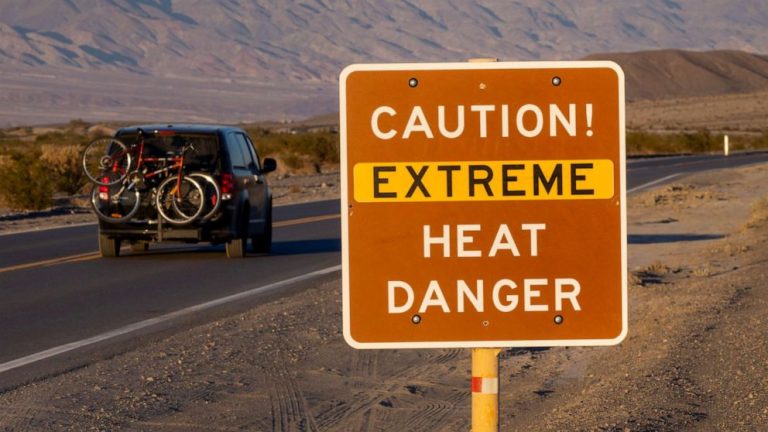Potentially deadly weather conditions are affecting millions of Americans from coast to coast.
Extreme heat, poor air quality and severe storms threatening flash flooding are expected to sweep areas across the country on Sunday.
More than 80 million Americans in 14 states from Washington to Florida are currently under heat warnings.
Forecasts show that the temperature in Furnace Creek in Death Valley, California, could reach 130 degrees for the first time since 2021. Temperatures on Saturday were recorded at 126 degrees.
The first two weeks of July were the hottest on record in Phoenix and Tucson, Arizona, as well as on the other side of the country in Tampa, Fort Myers and Key West, Florida.
In the Northeast, more than 56 million people are under flood watches, with heavy rain falling Sunday morning, causing flash flooding in parts of Virginia, Pennsylvania and New Jersey.
The city of El Paso, Texas, witnessed a temperature of 100 degrees for 30 days in a row, breaking the previous record. Forecasts call for temperatures to rise to triple digits for at least the next week.
Elsewhere in the country, record high daily temperatures are expected to be broken in at least 38 cities from Oregon to Florida, including California cities like Palm Springs, Fresno and Sacramento. The Arizona cities of Flagstaff, Phoenix and Tucson; Las Vegas and Reno, Nevada; El Paso, Houston, Austin and Corpus Christi in Texas; And Salt Lake City.
On Saturday, Phoenix broke its daily record when it reached 118 degrees, extending temperatures above 110 degrees for 16 days.
The South is also still dealing with high temperatures, with heat indexes along the Gulf Coast expected to reach over 110 degrees next week. Miami has been upgraded to an excessive heat warning through Monday when the heat index is expected to reach 112 degrees.
The smoke that has been over the upper Midwest for the past two days is about to move east as 900 wildfires continue to burn in Canada, the vast majority in British Columbia. More than half of the fires in Canada are described as “out of control.”
Forecasts show that by 6 PM ET, the smoke will have reached Cleveland and eastern Kentucky.
On Monday at 7 a.m. ET, smoke will remain thick from Montana to Nebraska, while the thick plume of easterly smoke along the eastern part of western New York will reach the Smoky Mountains and Asheville, North Carolina.
By Monday afternoon, smoke is expected to become very dense over parts of New York and Pennsylvania. For now, it looks like New York City will remain under only light conditions through Monday.
Areas from Montana to Chicago woke up to poor air quality and hazy skies Sunday morning, and Chicago was among the cities with the worst air quality in the world this morning, according to IQAir.
The influx of rain comes as a continuation of the flash flood conditions that swept the area on Saturday. More than 3 inches of rain fell in Williamsport, Pennsylvania, on Saturday, causing flash flooding and killing at least five people.
The ground is already very saturated in much of the Northeast after more than a week of rain, increasing the risk of flooding. The National Oceanic and Atmospheric Administration's Weather Prediction Center issued a medium-risk warning for heavy rainfall from Maine to Delaware, including large cities such as New York City and Philadelphia, indicating the potential for several flash floods, with significant events possible.
A tornado warning was also issued for 14 million people in the Northeast until 3 p.m. The warning includes much of Long Island, New York, all of Connecticut, most of Massachusetts, New Hampshire, and parts of Rhode Island and southern Maine. Flash flood and severe thunderstorm warnings have already been issued in those areas.
The heaviest and strongest storms will move through the Northeast on Sunday morning and through the afternoon. The forecast shows that the storms are expected to subside by the evening, with the exception of some continued activity from upstate New York to Vermont.

